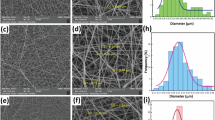Abstract
Calcium silicate ceramic coatings have received considerable attention in recent years due to their excellent bioactivity and bonding strength. However, their high dissolution rates limit their practical applications. In this study, zinc incorporated calcium silicate based ceramic Ca2ZnSi2O7 coating was prepared on Ti-6Al-4V substrate via plasma spraying technology aiming to achieve higher chemical stability and additional antibacterial activity. Chemical stability of the coating was assessed by monitoring mass loss and ion release of the coating after immersion in the Tris–HCl buffer solution and examining pH value variation of the solution. Results showed that the chemical stability of zinc incorporated coating was improved significantly. Antimicrobial activity of the Ca2ZnSi2O7 coating was evaluated, and it was found that the coating exhibited 93% antibacterial ratio against Staphylococcus aureus. In addition, in vitro bioactivity and cytocompatibility were confirmed for the Ca2ZnSi2O7 coating by simulated body fluid test, MC3T3-E1 cells adhesion investigation and cytotoxicity assay.











Similar content being viewed by others
References
Siriphannon P, Kameshima Y, Yasumori A, Okada K, Hayashi S. Influence of preparation conditions on the microstructure and bioactivity of alpha-CaSiO3 ceramics: formation of hydroxyapatite in simulated body fluid. J Biomed Mater Res. 2000;52(1):30–9.
De Aza PN, Luklinska ZB, Martinez A, Anseau MR, Guitian F. Morphological and structural study of pseudowollastonite implants in bone. J Microsc-Oxford. 2000;197:60–7.
Gou ZG, Chang J. Synthesis and in vitro bioactivity of dicalcium silicate powders. J Eur Ceram Soc. 2004;24(1):93–9.
Xue WC, Liu XY, Zheng XB, Ding CX. In vivo evaluation of plasma-sprayed wollastonite coating. Biomaterials. 2005;26(17):3455–60.
Sun LM, Berndt CC, Gross KA, Kucuk A. Material fundamentals and clinical performance of plasma-sprayed hydroxyapatite coatings: a review. J Biomed Mater Res. 2001;58(5):570–92.
Liu XY, Tao SY, Ding CX. Bioactivity of plasma sprayed dicalcium silicate coatings. Biomaterials. 2002;23(3):963–8.
Wu CT, Ramaswamy Y, Soeparto A, Zreiqat H. Incorporation of titanium into calcium silicate improved their chemical stability and biological properties. J Biomed Mater Res A. 2008;86A(2):402–10.
Liang Y, Xie YT, Ji H, Huang LP, Zheng XB. Excellent stability of plasma-sprayed bioactive Ca3ZrSi2O9 ceramic coating on Ti-6Al-4V. Appl Surf Sci. 2010;256(14):4677–81.
Liu XY, Ding CX. Plasma sprayed wollastonite/TiO2 composite coatings on titanium alloys. Biomaterials. 2002;23(20):4065–77.
Tapiero H, Tew KD. Trace elements in human physiology and pathology: zinc and metallothioneins. Biomed Pharmacother. 2003;57(9):399–411.
Ma ZJ, Yamaguchi M. Stimulatory effect of zinc on deoxyribonucleic acid synthesis in bone growth of newborn rats: enhancement with zinc and insulin-like growth factor-I. Calcified Tissue Int. 2001;69(3):158–63.
Storrie H, Stupp SI. Cellular response to zinc-containing organoapatite: an in vitro study of proliferation, alkaline phosphatase activity and biomineralization. Biomaterials. 2005;26(27):5492–9.
Wu CT, Ramaswamy Y, Chang J, Woods J, Chen YQ, Zreiqat H. The Effect of Zn contents on phase composition, chemical stability and cellular bioactivity in Zn–Ca–Si system ceramics. J Biomed Mater Res B. 2008;87B(2):346–53.
Chen YK, Zheng XB, Xie YT, Ji H, Ding CX. Antibacterial properties of vacuum plasma sprayed titanium coatings after chemical treatment. Surf Coat Tech. 2009;204(5):685–90.
Masse A, Bruno A, Bosetti M, Biasibetti A, Cannas M, Gallinaro P. Prevention of pin track infection in external fixation with silver coated pins: clinical and microbiological results. J Biomed Mater Res. 2000;53(5):600–4.
Wu CT, Chang J, Zhai WY. A novel hardystonite bioceramic: preparation and characteristics. Ceram Int. 2005;31(1):27–31.
Gell M, Jordan EH, Sohn YH, Goberman D, Shaw L, Xiao TD. Development and implementation of plasma sprayed nanostructured ceramic coatings. Surf Coat Tech. 2001;146:48–54.
Wu CT, Ramaswamy Y, Kwik D, Zreiqat H. The effect of strontium incorporation into CaSiO3 ceramics on their physical and biological properties. Biomaterials. 2007;28(21):3171–81.
Zreiqat H, Ramaswamy Y, Wu C, Paschalidis A, Lu Z, James B, et al. The incorporation of strontium and zinc into a calcium–silicon ceramic for bone tissue engineering. Biomaterials. 2010;31(12):3175–84.
Kokubo T, Takadama H. How useful is SBF in predicting in vivo bone bioactivity? Biomaterials. 2006;27(15):2907–15.
Liu XY, Ding CX. Morphology of apatite formed on surface of wollastonite coating soaked in simulate body fluid. Mater Lett. 2002;57(3):652–5.
Esposito M, Hirsch JM, Lekholm U, Thomsen P. Biological factors contributing to failures of osseointegrated oral implants. (II). Etiopathogenesis. Eur J Oral Sci. 1998;106(3):721–64.
Campoccia D, Montanaro L, Arciola CR. The significance of infection related to orthopedic devices and issues of antibiotic resistance. Biomaterials. 2006;27(11):2331–9.
Gross M, Cramton SE, Gotz F, Peschel A. Key role of teichoic acid net charge in Staphylococcus aureus colonization of artificial surfaces. Infect Immun. 2001;69(5):3423–6.
Amro NA, Kotra LP, Wadu-Mesthrige K, Bulychev A, Mobashery S, Liu GY. High-resolution atomic force microscopy studies of the Escherichia coli outer membrane: structural basis for permeability. Langmuir. 2000;16(6):2789–96.
Feng QL, Wu J, Chen GQ, Cui FZ, Kim TN, Kim JO. A mechanistic study of the antibacterial effect of silver ions on Escherichia coli and Staphylococcus aureus. J Biomed Mater Res. 2000;52(4):662–8.
Xua JA, Ding G, Li JL, Yang SH, Fang BS, Sun HC, et al. Zinc-ion implanted and deposited titanium surfaces reduce adhesion of Streptococccus mutans. Appl Surf Sci. 2010;256(24):7540–4.
Sondi I, Salopek-Sondi B. Silver nanoparticles as antimicrobial agent: a case study on E. coli as a model for Gram-negative bacteria. J Colloid Interf Sci. 2004;275(1):177–82.
Anselme K. Osteoblast adhesion on biomaterials. Biomaterials. 2000;21(7):667–81.
Acknowledgments
This study was supported by the National Natural Science Foundation of China (Grant No. 81071455) and the Fund for Key Science and Technology Program of Shanghai Science and Technology Committee (Grant No. 09441900106).
Author information
Authors and Affiliations
Corresponding author
Additional information
Kai Li and Jiangming Yu are contributed equally to this work.
Rights and permissions
About this article
Cite this article
Li, K., Yu, J., Xie, Y. et al. Chemical stability and antimicrobial activity of plasma sprayed bioactive Ca2ZnSi2O7 coating. J Mater Sci: Mater Med 22, 2781–2789 (2011). https://doi.org/10.1007/s10856-011-4454-9
Received:
Accepted:
Published:
Issue Date:
DOI: https://doi.org/10.1007/s10856-011-4454-9




